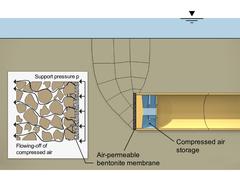
|

This presentation is part of the series of presentations "Utility Tunnelling" and deals with the various types of shield machines, the removal of obstacles and possible errors in pipe jacking. |
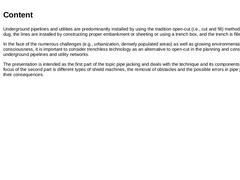
|

Underground pipelines and utilities are predominantly installed by using the tradition open-cut (i.e., cut and fill) method: a trench is dug, the lines are installed by constructing proper embankment or sheeting or using a trench box, and the trench is filled afterwards. In the face of the numerous challenges (e.g., urbanization, densely populated areas) as well as growing environmental consciousness, it is important to consider trenchless technology … |
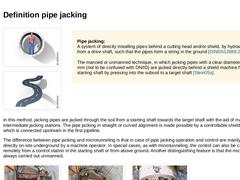
|

(Image: Manned techniques) (Image: Steerable techniques) Pipe jacking:
A system of directly installing pipes behind a cutting head and/or shield, by hydraulic jacking from a drive shaft, such that the pipes form a string in the ground [DINEN12889:2000].
The manned or unmanned technique, in which jacking pipes with a clear diameter ≥ 1200 mm (not to be confused with DN/ID) are jacked directly behind a shield machine from a starting shaft by pressing … |

|

The components required for pipe jacking depend on the variant used to support the workface or convey excavated soil. However, the following key components are essential: -
Control and steering desk
-
Crane
-
Jacking pipes
-
Shield machine (tunnel boring machine)
-
Intermediate jacking station
-
Main jacking station
-
Abutment
-
Pipe brake
(Image: Schematic presentation of a pipe jacking - NEU) (Video: Pipe jacking in Bahrain) |

|

|
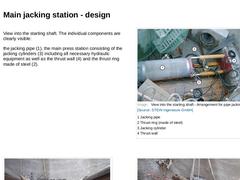
|

View into the starting shaft. The individual components are clearly visible: the jacking pipe (1), the main press station consisting of the jacking cylinders (3) including all necessary hydraulic equipment as well as the thrust wall (4) and the thrust ring made of steel (2). (Image: View into the starting shaft - Arrangement for pipe jacking) (Image: Damage to the jacking abutment due to inadequate dimensioning - Jacking forces cannot be absorbed by … |

|

A shield machine is a steerable shoring construction, in the protection of which the soil / rock on the working face is excavated manually, mechanically or hydraulically. It consists of at least two flexible connected steel pipe pieces, the front shield segment and the trailing shield segment, which is supported by the jacking pipe string. A distinction is made here between open and closed shields or shields with partial and full face excavation.… |

|

|
(Image: Attention!)
The feature of shield machines, also called shields, for pipe jacking, is that the thrust jacks (jacking cylinders) are situated not in the shield machine, but in the (main) jacking station or in the first intermediate jacking station. |
|
The soil or rock material can be excavated at the working face with the following methods: |
|
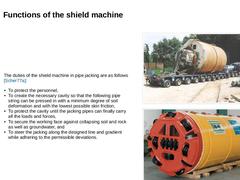
|

|
The duties of the shield machine in pipe jacking are as follows [Scher77a]: -
To protect the personnel,
-
To create the necessary cavity so that the following pipe string can be pressed in with a minimum degree of soil deformation and with the lowest possible skin friction,
-
To protect the cavity until the jacking pipes can finally carry all the loads and forces,
-
To secure the working face against collapsing soil and rock as well as groundwater, …
|
|
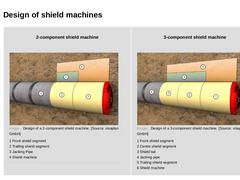
|

|
2-component shield machine (Image: Design of a 2-component shield machine) |
3-component shield machine (Image: Design of a 3-component shield machine) |
|
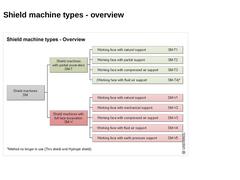
|

(Image: Overview of shield machine types) |
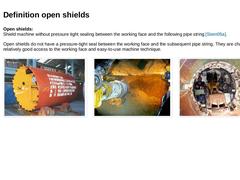
|

Open shields:
Shield machine without pressure tight sealing between the working face and the following pipe string [Stein05a]. Open shields do not have a pressure-tight seal between the working face and the subsequent pipe string. They are characterized by relatively good access to the working face and easy-to-use machine technique. (Image: Hand shields - Overall view of a hand shield (external diameter 2098 mm) [FI-Nishi]) (Image: Open shield) (Image: … |
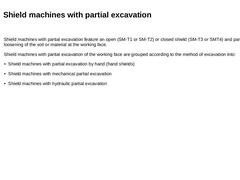
|

Shield machines with partial excavation feature an open (SM-T1 or SM-T2) or closed shield (SM-T3 or SMT4) and partial loosening of the soil or material at the working face. Shield machines with partial excavation of the working face are grouped according to the method of excavation into: -
Shield machines with partial excavation by hand (hand shields)
-
Shield machines with mechanical partial excavation
-
Shield machines with hydraulic partial excavation
|
|
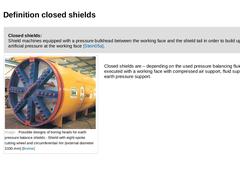
|

|
Closed shields:
Shield machines equipped with a pressure bulkhead between the working face and the shield tail in order to build up an artificial pressure at the working face [Stein05a]. |
(Image: Possible designs of boring heads for earth pressure balance shields - Shield with eight-spoke cutting wheel and circumferential rim (external diameter 3100 mm) [Breme])
Closed shields are – depending on the used pressure balancing fluid – executed with … |
|

|

| Shield machines with full-face excavation (SM-V) differ from those with partial excavation (SM-T) in that they process and loosen the whole working face in one working step by means of a rotating boring head equipped with corresponding excavation tools. | | (Image: Shield machines with full-face excavation - Working face with natural support SM-V1) | (Image: Shield machines with full-face excavation - Working face with mechanical support SM-V2) | | (Image: … |
|
|
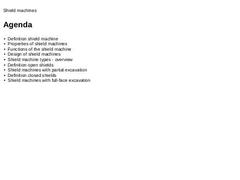
|

|
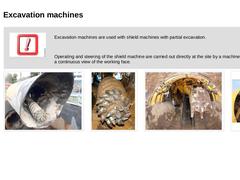
|

|
(Image: Attention!)
Excavation machines are used with shield machines with partial excavation. Operating and steering of the shield machine are carried out directly at the site by a machine operator who has a continuous view of the working face. |
|
(Image: Shield machine with fixed installed boom cutting machine - With axial cutting head) |
(Image: Axial cutter head of the boom cutting machine equipped with round shank cutter bits) |
(Image: Principles … |
|
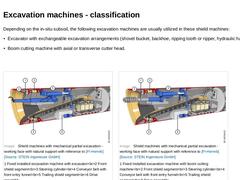
|

Depending on the in-situ subsoil, the following excavation machines are usually utilized in these shield machines: -
Excavator with exchangeable excavation arrangements (shovel bucket, backhoe, ripping tooth or ripper, hydraulic hammer)
-
Boom cutting machine with axial or transverse cutter head.
(Image: Shield machines with mechanical partial excavation - working face with natural support with reference to [FI-Herreb] [Image: S&P GmbH]) (Image: Shield … |
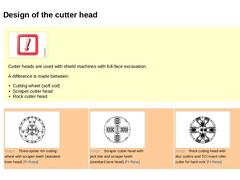
|

|
(Image: Attention!)
Cutter heads are used with shield machines with full-face excavation.
A difference is made between: -
Cutting wheel (soft soil)
-
Scraper cutter head
-
Rock cutter head
|
|
|
|
(Image: Three-spoke rim cutting wheel with scraper teeth (standard bore head) [FI-Rasa]) |
(Image: Scraper cutter head with pick bits and scraper teeth (standard bore head) [FI-Rasa]) |
(Image: Rock cutting head with disc cutters and TCI insert roller cutter … |
|
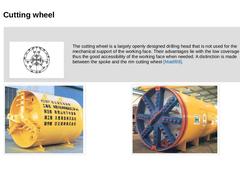
|

|
(Image: Three-spoke rim cutting wheel with scraper teeth (standard bore head) [FI-Rasa]) The cutting wheel is a largely openly designed drilling head that is not used for the mechanical support of the working face. Their advantages lie with the low coverage and thus the good accessibility of the working face when needed. A distinction is made between the spoke and the rim cutting wheel [Maidl98]. |
|
(Image: Possible designs of boring heads for earth … |
|
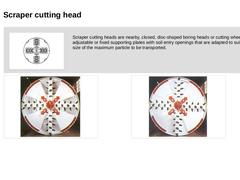
|

|
(Image: Scraper cutter head with pick bits and scraper teeth (standard bore head) [FI-Rasa])
Scraper cutter heads are nearby, closed, disc-shaped boring heads or cutting wheels with adjustable or fixed supporting plates with soil entry openings that are adapted to suit the size of the maximum particle to be transported. |
|
(Image: Open shield machine with scraper cutting head and mechanical support of the working face - Variably adjustable soil entry … |
|

|

|
(Image: Rock cutting head with disc cutters and TCI insert roller cutter for hard rock [FI-Rasa])
Rock cutter heads consist of almost closed, disc-shaped basic constructions with usual slot-shaped entry openings (removal slots) and are flat with a rounded periphery, slightly coned or almost convex. |
|
(Image: Rock cutter head of a shield with fluid support of the type AVN 1500 for jacking in rock - view) |
|
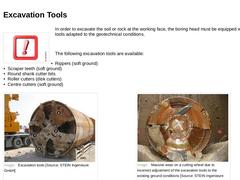
|

(Image: Attention!) In order to excavate the soil or rock at the working face, the cutter head must be equipped with excavation tools adapted to the geotechnical conditions. The following excavation tools are available: -
Rippers (soft ground)
-
Scraper teeth (soft ground)
-
Round shank cutter bits
-
Roller cutters (disk cutters)
-
Centre cutters (soft ground)
(Image: Excavation tools [Source: STEIN Ingenieure GmbH]) (Image: Massive wear on a cutting wheel … |
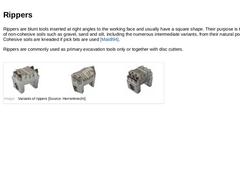
|

Rippers are blunt tools inserted at right angles to the working face and usually have a square shape. Their purpose is the loosening of non-cohesive soils such as gravel, sand and silt, including the numerous intermediate variants, from their natural positions. Cohesive soils are kneaded if pick bits are used [Maidl94]. Rippers are commonly used as primary excavation tools only or together with disc cutters. (Image: Variants of rippers ) |
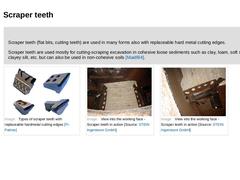
|

Softground tools as buckets and cutting knifes are used in many forms also with replaceable hard metal cutting edges. Buckets and cutting knifes are used mostly for cutting-scraping excavation in cohesive loose sediments such as clay, loam, soft slate, clayey silt, etc. but can also be used in non-cohesive soils [Maidl94]. Buckets: Transportation of excavated material to the excavation chamber or into the reamer channels. They are built in lip segments … |
|